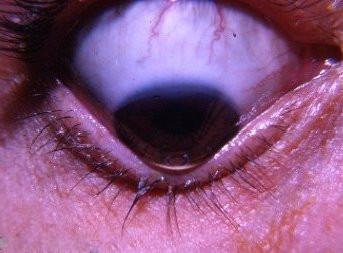Keratoconus
Watchlist
Retrieved
2022-04-26
Source
Trials
—
Genes
VSX1,
MIR184,
FOXO1,
FNDC3B,
ZNF469,
AIPL1,
CRB1,
PRDM5,
TOPORS,
SAG,
NMNAT1,
LMX1B,
RPE65,
KCNJ13,
LOX,
SEMA4A,
IFT172,
ABCA4,
IMPDH1,
PRPF31,
MAK,
FSCN2,
IDH3B,
IDH3A,
ZNF408,
HRAS,
DHDDS,
MAP3K19,
CEP290,
PIEZO2
VSX1,
MIR184,
FOXO1,
FNDC3B,
ZNF469,
AIPL1,
CRB1,
PRDM5,
TOPORS,
SAG,
NMNAT1,
LMX1B,
RPE65,
KCNJ13,
LOX,
SEMA4A,
IFT172,
ABCA4,
IMPDH1,
PRPF31,
MAK,
FSCN2,
IDH3B,
IDH3A,
ZNF408,
HRAS,
DHDDS,
MAP3K19,
CEP290,
PIEZO2,
AGBL5,
GUCY2D,
SLC7A14,
IMPG2,
SCAPER,
PLOD1,
RGR,
RHO,
RLBP1,
AHI1,
ROM1,
PDE6B,
PDE6G,
PDE6A,
PCYT1A,
RP9,
NRL,
POMGNT1,
RP1,
RP2,
SPATA7,
NEK2,
KIZ,
KLHL7,
RPGRIP1,
MERTK,
KIAA1549,
RPGR,
PRPF6,
ARL2BP,
GUCA1B,
CLRN1,
CNGB1,
RD3,
EYS,
BEST1,
CERKL,
IFT88,
CA4,
PCARE,
BBS2,
PRPF8,
OFD1,
GDF6,
ARL3,
PROM1,
PRPF4,
PRPF3,
LRAT,
IQCB1,
AHR,
PRCD,
IFT140,
DHX38,
NR2E3,
CNGA1,
USH2A,
RBP3,
TTC8,
SLC2A10,
ARL6,
FOXE3,
FAM161A,
ANTXR1,
USP45,
CDHR1,
REEP6,
COL3A1,
ARHGEF18,
CRX,
ZNF513,
UBXN4,
SNRNP200,
HGSNAT,
RDH12,
TUB,
TULP1,
C8orf37,
LCA5,
PRPH2,
SOD1,
TGFBI,
TIMP1,
MMP9,
COL4A4,
IL1B,
HGF,
IL6,
RAB3GAP1,
DOCK9,
IL1A,
COL4A3,
COL5A1,
TIMP3,
MPDZ,
PLK3,
PLXNA2,
PIP,
RXRA,
CAST,
CAT,
ACTB,
COL8A2,
PPRC1,
KLF6,
BANP,
CTSB,
PRL,
TGFB1,
TGFB2,
TIMP2,
ROBO3,
PYCARD,
SFTPA1,
AQP5,
SFRP1,
NGF,
MMP2,
ATM,
IL1RN,
MIR17HG,
ETDA,
PROB1,
KTCN8,
ADAMTS17,
SERINC3,
HPSE,
MIR568,
POTEF,
KERA,
NOX4,
ADAMTS8,
MMRN1,
GAL,
PLLP,
KIF26B,
NAXD,
ANAPC1,
IL17B,
GALNT14,
NEIL1,
HKDC1,
WNT10A,
ABCA6,
SLC4A11,
GGTLC1,
TUBA3D,
ARC,
A2M,
SLPI,
STK24,
LGALS3,
CTSV,
CYBB,
DSG3,
ELAVL1,
EMP3,
ENO1,
PTK2B,
FLG,
GABPA,
GCLC,
GPX1,
GSN,
HLA-A,
HMOX1,
HMOX2,
HTC2,
IPO5,
KRT3,
KRT12,
CTSG,
CST4,
CREB1,
ATF4,
ACP2,
ADH1B,
PARP1,
AKT1,
ALDH3A2,
APEX1,
FAS,
FASLG,
BAD,
COL8A1,
BDNF,
CASP9,
CCT,
CLC,
CNTF,
COL4A1,
COL4A2,
COL6A1,
LGALS1,
LIG3,
XRCC1,
SMAD2,
SLC7A2,
SOD3,
SP1,
STATH,
ZEB1,
TF,
TFAM,
TLR2,
TLR4,
TNF,
TNFRSF1A,
TNFRSF1B,
TSC1,
TSC2,
TWIST1,
TYMS,
UGCG,
WNT3,
WNT5A,
CCL24,
S100A6,
S100A4,
NGFR,
SMAD7,
MEFV,
MMP1,
MMP3,
MSD,
COX1,
ND1,
NFE2L2,
NOTCH1,
S100A2,
NT5E,
PIK3CA,
PIK3CB,
PIK3CD,
PIK3CG,
POLG,
RAD51,
REST,
LOC102724197
Drugs
—
Registered!

Keratoconus is the degeneration of the structure of the cornea, which is the clear tissue covering the front of the eye. In this condition, the shape of the cornea slowly changes from the normal round shape to a cone shape. Most people who develop keratoconus start out nearsighted, which tends to become worse over time. The earliest symptom is a slight blurring of vision that cannot be corrected with glasses. Over time, there may be eye halos, glare, or other night vision problems.The cause is unknown, but the tendency to develop keratoconus is probably present from birth. Keratoconus is thought to involve a defect in collagen, the tissue that makes up most of the cornea. Some researchers believe that allergy and eye rubbing may play a role. Treatment for keratoconus depends on the severity of your condition and how quickly the condition is progressing.
Mild to moderate keratoconus can be treated with eyeglasses or contact lenses.
In some people the cornea becomes scarred or wearing contact lenses becomes difficult. In these cases, surgery might be necessary.